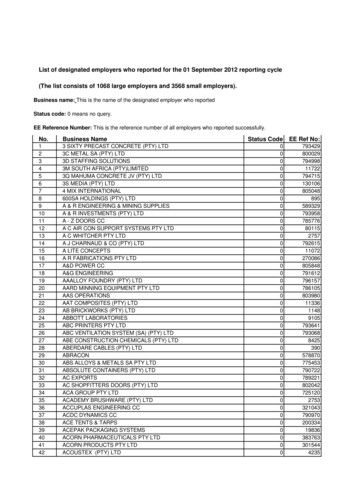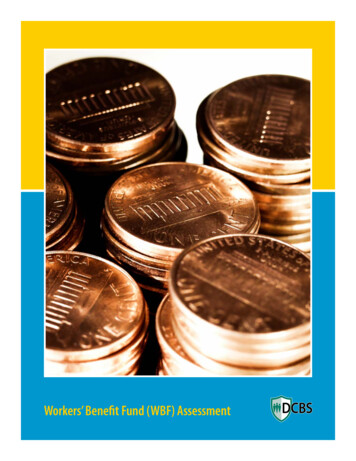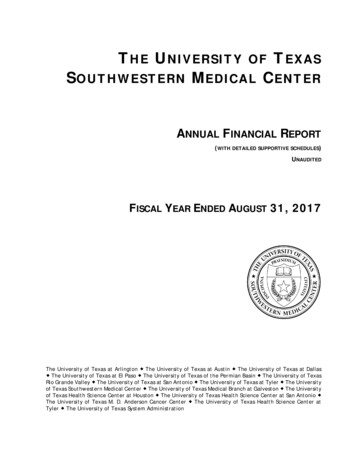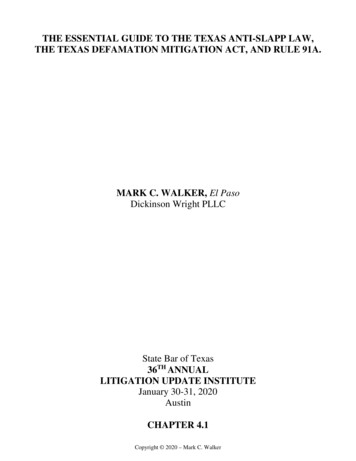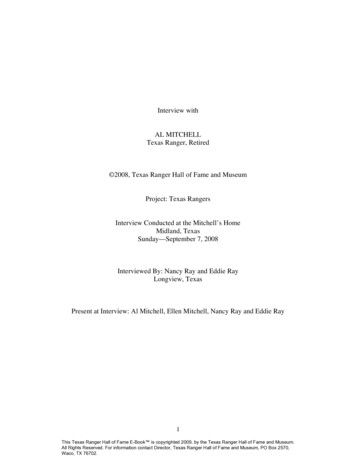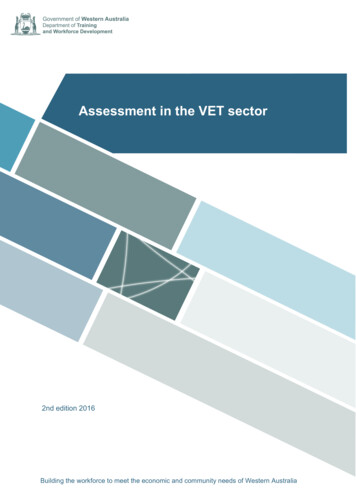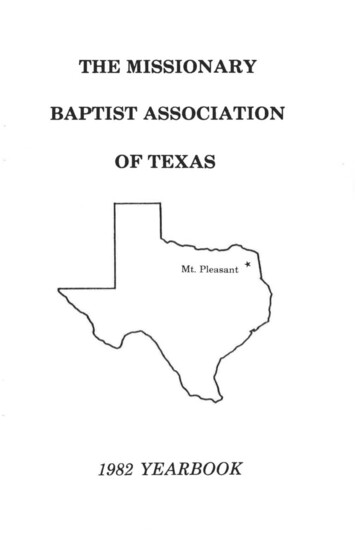
Transcription
Employers’ Assessment of Texas State University MPA ProgrambyRosalinda Trevino MooreAn Applied Research Project(Political Science 5397)Submitted to the Department of Political ScienceTexas State UniversityIn Partial Fulfillment for the Requirements for the Degree ofMasters of Public AdministrationSpring 2009Faculty Approval:
MooreiTABLE OF CONTENTSList of Tables . ivAbstract . vAbout the Author . viAcknowledgments . viiTexas State University-San Marcos MPA Program . viiiChapter 1 INTRODUCTION. 1Chapter Purpose .1Descriptive Research Purpose .2Preview of Chapters .3Chapter 2 EDUCATIONAL PROGRAM ASSESSMENT . 5Chapter Purpose .5Introduction to Educational Program Assessment.6Assessment in Higher Education .7Assessments That Focus on Students .7Assessments That Focus on Stakeholders.9Assessment Methods . 17Chapter Summary . 17Chapter 3 TEXAS STATE UNIVERSITY MPA PROGRAM . 20Chapter Purpose . 20Texas State University MPA Program Mission Statement - 2009 . 20Compliance with NASPAA Standards . 21Historical Perspective- NASPAA . 23NASPAA Criteria for Mission Statements and Curriculum . 23Modifications to NASPAA Standards on Program Mission and Outcomes Assessments . 26Limitations of NASPAA Standards . 27NASPAA Self-Study . 27Table 3.1: Texas State University Surveys and Analysis of Applied Research Projects (1993 –2009) . 29Chapter Summary . 30Chapter 4 WHAT EMPLOYERS BELIEVE MPA STUDENTS SHOULD KNOW. 31Chapter Purpose . 31Career-development Approach . 31Texas State University Employer Surveys . 32Texas City Managers‘ Expectations . 32Texas Executive Directors‘ Expectations . 35Chapter Summary . 37
iiMooreChapter 5 REPUTATIONAL SURVEY OF MPA PROGRAM AND CONCEPTUALFRAMEWORK . 40Chapter Purpose . 40Conceptual Framework . 40Purpose of Descriptive Conceptual Framework . 41Descriptive Categories of Employer Assessment Survey . 41Conceptual Framework Linked to Literature Review . 47Table 5.1: Conceptual Framework Linked to Literature Review. 48Chapter Summary . 49Chapter 6 EMPLOYER ASSESSMENT SURVEY METHODOLOGY . 50Chapter Purpose . 50Employer Assessment of Texas State University MPA Program Graduates. . 50Research Technique – Methodology . 50Employer Surveys. 51Strengths and Weaknesses of Survey Research . 52Sampling and Population . 52Operationalization of Conceptual Framework . 54Evaluation of Responses to Employer Surveys . 54Additional Employer Survey Open-Ended Questions . 55Human Subjects Protection – Information About the Research . 55Chapter Summary . 57Chapter 7 EMPLOYER SURVEY RESULTS . 59Chapter Purpose . 59Description of Returned Surveys . 59General Characteristics . 60Mission-Driven Outcomes . 61Knowledge, Skills, and Abilities – NASPAA curriculum standards . 61Student Learning Outcomes – Texas State University MPA Program . 63Other Skill Sets – What Employers Believe Students Should Know . 64Survey Comments to Open-Ended Questions . 65How many Texas State MPA graduates have you worked closely with in the past seven years? . 65What kind of positions did these Texas State MPA graduates have? . 66What is the reputation of Texas State MPA program? . 66Chapter Summary . 68Chapter 8 CONCLUSION . 69Chapter Purpose . 69Summary of Research . 69Recommendations for Future Research. 73Bibliography . 75
MooreiiiAppendices . 80Appendix A.1: Employer Survey Questionnaire . 80Appendix A.2: Employer Survey Questionnaire - continued . 81Appendix A.3: Employer Survey Questionnaire - continued . 82Appendix B: Mission-Driven Outcomes – Texas State MPA Employer Survey Results . 83Appendix C: Knowledge, Skills, and Abilities (NASPAA Curriculum Standards) – Texas StateMPA Program Employer Survey Results. 84Appendix D: Student Learning Outcomes – Texas State MPA Program Employer Survey Results. 85Appendix E: Other Skill Sets – Texas State MPA Program Employer Survey Results . 86Appendix F: MPA Employer Survey Results - General Characteristics . 87Appendix G: Working with Texas State MPA Graduates in the Past Seven Years – EmployerSurvey Results . 88Appendix H: Positions Held by Texas State MPA graduates . 89Appendix I: Reputation of Texas State MPA Program . 90
ivMooreList of TablesTable 2.1: Ranking of Texas State MPA Core Curriculum in Order of Importance . 14Table 2.2: Texas State University Reputational Surveys (2002 – 2009) . 16Table 3.1: Texas State University Surveys and Analysis of Applied Research Projects (1993 – 2009) . 29Table 4.1: Most Important Components as Perceived by Texas City Managers (CM) and Executive Directors(ED) by Category (Lee 2006; Sinclair 2005) . 33Table 4.2: Texas City Managers Ranking in Order of Importance with Percentages of Most Important . 35Table 4.3: Texas Executive Directors Ranking in Order of Importance with Percentages of Most Important 36Table 4.4: Texas City Managers and Executive Directors Highest Ranking of Sub-categories of Knowledge,Skills, and Abilities . 38Table 5.1: Conceptual Framework Linked to Literature Review . 48Table 6.1: Operationalization of Conceptual Framework . 58Table 7.1: Employer Characteristics . 60Table 7.2: Familiarity with Texas State MPA Program . 60Table 7.3: MPA Program Mission-Driven Outcomes Results . 61Table 7.4: Knowledge, Skills, and Abilities - NASPAA Curriculum Standards Results . 63Table 7.5: Student Learning Outcomes - Texas State MPA Program . 64Table 7.6: Other Skill Sets - Texas State MPA Program . 65Table 7.7: Working with Texas State MPA Graduates . 65Table 7.8: Reputation of Texas State MPA Program . 67Table 7.9: Comments Regarding Reputation of Texas State MPA Program . 68Table 8.1: Texas State MPA Program Reputational Survey Results with Corresponding Means . 70Table 8.2: What Employers Believe MPA Graduates Should Know in Order of Importance . 72
MoorevAbstractResearch PurposeThe purpose of this research is to describe the perceptions and opinions of employers ofgraduates of the master of public administration program (MPA) from Texas State Universityregarding their knowledge, skills, and abilities. The research purpose is descriptive in nature. Anemployer assessment survey was performed to ascertain the reputation of MPA graduates. TheMPA program benefits by knowing how the graduates are perceived by the labor market. Theresearch reviews what employers believe MPA graduates should know, and how the MPAgraduates are perceived by their employers.MethodThis study uses two techniques to gather the perceptions and opinions of employers ofTexas State MPA program graduates: employer assessment survey and content analysis, withcategorization of the responses to the open-ended questions and statements on the employersurvey. The content analysis only applies to the responses of the open-ended questions andstatements that are part of the employer survey.FindingsEmployers perceive the Texas State MPA program meets its mission in imparting theknowledge, skills, and abilities to its students to prepare them for public administration service.Overall, the MPA program is highly regarded. The positions that MPA graduates hold in publicservice support Castleberry‘s argument that ―[t]he advantages of student learning outcomes alsoextend well beyond college campuses.‖ (2006, 16).
viMooreAbout the AuthorI wanted to get my master's degree right after I received my bachelor's degree, but someof my choices in life prevented me from reaching that goal until now that I am retired fromTexas state government. One thing is for sure, I have never lost the desire to learn. My parentsinculcated in me the importance of education in order to succeed in life. They made manysacrifices to help me get an education, which has provided me a better life than the one they hadin México.I was raised in México until the age of 15, when my parents moved the family to theUnited States – the land of opportunity. I received my bachelor‘s degree in businessadministration with a concentration in accounting from the University of Texas at Austin. Iearned my CPA license two years later after working for the Texas State Auditor‘s office as anassistant state auditor. However, most of my public service career in state government was at theEmployees Retirement System of Texas, where I worked in the finance departmentapproximately 24 years. In the process, and as part of my continuing professional education, Iearned many professional designations in public management (CPM), public finance (CPFO),government financial management (CGFM), and employee benefits (CEBS).To contact me, please email me at rosy-john-moore@austin.rr.com.
MooreAcknowledgmentsI want to thank Patricia M. Shields, Ph.D., for advising me and giving me direction inthis applied research project; Howard R. Balanoff, Ph.D., for encouraging me to obtain mymaster‘s degree in public administration; Jennifer Small for her professional editing, and manyother friends and family members that continued to encourage me to finish my degree eventhough I was a nontraditional student at Texas State University-San Marcos.I want to thank my parents, Rosalinda V. Treviño (deceased) and Jose Treviño, forinstilling in me the desire to obtain an education. They had the foresight to bring their sixchildren to a better way of life in the United States. I wish my mother would have lived longenough to see my graduation from the MPA program at Texas State University-San Marcos.Most of all, I want to thank my beloved husband, John D. Moore. He has put up withme during endless hours of studying and complaining of too much homework. I have earnedmany professional designations, and now I will receive my master's degree thanks to hisunending patience, love, and support.vii
viiiMooreTexas State University-San Marcos MPA ProgramPi Alpha Alpha Inductees, May 20081American Society for Public AdministrationCentex Chapter Public Service Recognition WeekThe Centex Chapter of ASPA held its annual award ceremony on Friday, May 2, 2008 at theMarriott Hotel in Austin, Texas. The awards banquet honored the people and programs ofgovernment, education, nonprofit and advocacy sectors meeting the needs of Central Texas.The event featured keynote speaker, Brewster McCracken, of the Austin City Council, whospoke about technology as a tool for transformation and meeting citizen's needs, today andtomorrow.Dr. Kay Hofer, Professor of Political Science, won the Educator of the Year Award.Also, three James W. McGrew Research Awards were presented to Chance Sparks, JoySchneider-Cowan and Stephen Este. All three McGrew Award winners are Texas StateUniversity-San Marcos MPA Graduates.Inducted into the Pi Alpha Alpha Honor Society were Jason Alexander, Daniel Reed, CassandraCasillas, James Twine, Dustin McLemore, and Rosalinda Moore [Picture above].Congratulations to all the award winners!1News release was reported in Texas State University‘s website at a-may-2008.html.
Moore1Chapter 1 INTRODUCTIONChapter PurposeThe purpose of this chapter is to introduce the research purpose and to previewthe chapters of this applied research project.Unrelenting pressure for accountability in education has compelledadministrators to establish or clarify standards of performance from the highest to thelowest levels of administrative operations and programs in both the public and privatesectors. Educational institutions have developed various assessment vehicles to gaugeand monitor performance of educational programs and the institutions as a whole. One ofthose assessment vehicles is employer assessment surveys.Educational institutions seek feedback from constituents as a way to assessperformance and stimulate improvement. ―Constituents of higher education includegovernors, legislators, higher education policy makers, accrediting bodies, parents,faculty, and students.‖ (Apostolou 1999, 178). In addition, educational institutions seekfeedback from alumni and employers to improve their educational programs.This research focuses on the employers‘ assessment of Texas State Universitygraduates from the master of public administration program in relation to theirdemonstrated knowledge, skills, and abilities. Employer assessment is important becauseemployers are the stakeholders empowered to hire the alumni with the requisiteknowledge and skills– the final product of the educational institutions. Apostoloudeclares that the results of a study conducted by Karakaya and Karakaya in 19962, showthat the researchers believe the employer focus is important because students select an2See Karakaya and F. Karakaya. 1996. Employer expectations from a business education. Journal of Marketing forHigher Education 7: 9-16 as cited by Apostolou 1999, 193.
2Mooreeducational institution based on their expectations to obtain a good job after graduation(Apostolou 1999, 193).Descriptive Research PurposeThe purpose of this research is to describe the perceptions and opinions ofemployers of graduates of the master of public administration program (MPA) fromTexas State University regarding their knowledge, skills, and abilities. The researchpurpose is descriptive in nature. An employer assessment survey was performed toascertain the reputation of MPA graduates and to find out what employers believestudents should know. The MPA program benefits by knowing how graduates areperceived by the labor market. This research reviews what employers believe MPAgraduates should know, and how the MPA graduates are perceived by their employers.The project uses employer surveys as a vehicle to assess how the Texas StateMPA program meets the requirements of employers and to discover how employersperceive the quality of MPA graduates they employ. The employer assessment isimportant because outside forces such as the economy, mandated legislation, the politicalenvironment, and the goods and services customers demand influence what employersrequire from their employees. The employer assessment study is a partial requirement ofthe re-accreditation process of the MPA program at Texas State University by theNational Association of Schools of Public Affairs and Administration (NASPAA).NASPAA requires that the Texas State MPA program prepare a self-study every sevenyears to receive re-accreditation (Texas State NASPAA Self-Study Report 2002;NASPAA 2008).
Moore3The employer assessment of the Texas State University MPA program serves asa tool to gauge the perceptions and opinions of employers on how well the MPA programmeets its mandate. The Texas State MPA program strives to reach its mission, NASPAAcore curriculum requirements, student learning outcomes, and other requirementsemployers may have for Texas State MPA graduates employed in their organizations.Texas State University administrators may use the results of the study to makemodifications to the program mission3 and curriculum. The Texas State MPA programadministrators regularly seek feedback from alumni, practitioners (employers andstudents), and other users of their educational program so that they may improve uponthem.Collecting data from employers of MPA graduates is important because thegraduates and their employers are the ultimate users of acquired program knowledge andskills. To that end, Apostolou (1999, 193) emphasizes, ―Understanding what consumersof educational outcomes desire is important to establishing desired outcomes andproducing requisite inputs.‖Hermes (2002), Sinclair (2005), and Lee (2006) conducted employer surveys orinterviews to determine what the employers desire from Texas State MPA graduates andthe value they place on the program knowledge, skills, and abilities. This research projectreviews and summarizes some of their findings and recommendations.Preview of ChaptersThis research study is organized into eight chapters. Chapter 2 contains theliterature review and introduces the educational program assessment efforts, theassessment in higher education and masters of public administration programs, the3The Texas State MPA program revised its mission statement in January 2009.
4Mooreassessments that focus on students, alumni, and employers, and selected methods ofassessment. Chapter 3 includes the research setting at Texas State University-SanMarcos, its MPA program and mission statement, and the accreditation standards forMPA programs established by NASPAA. Chapter 4 covers the findings of two employersurveys conducted by Texas State University in 2005 and 2006 by summarizing andcomparing the results of the studies. Chapter 5 develops the conceptual framework of thereputational employer survey for the Texas State MPA program using categories from itsmission statement, NASPAA standards of curriculum components, MPA program studentlearning outcomes, and other skill sets employers expect. Chapter 6 describes themethodology of the research and operationalizes the conceptual framework. Chapter 7discusses the results of the employer assessment survey using simple descriptivestatistics, and Chapter 8 presents a conclusion and summary of the results, andrecommendations for future research.
Moore5Chapter 2 EDUCATIONAL PROGRAM ASSESSMENTThrough assessment, educators meet responsibilitiesto students and to the public.American Association for Higher Education and Accreditation(AAHEA) – 9th PrincipleChapter PurposeThe purpose of this chapter is to provide an overview of the educationalprogram assessment environment in higher education with a focus on alumni andemployers as stakeholders of the master of public administration programs. The researchemphasis is on reputational studies and what employers believe alumni should posses inknowledge, skills, and abilities.The literature review introduces the educational program assessment efforts, theassessment in higher education and masters of public administration programs, theassessments that focus on students, alumni, and employers, and other selected assessmentmethods. The literature review lays the foundation to discover what type of information isneeded from an employer assessment survey to answer the following questions: How well is an educational program, specifically an MPA program,reaching its mission? How well is the MPA educational program complying with accreditationstandards? How well is the MPA program helping students meet the establishedstudent learning outcomes? What do employers believe the Texas State MPA graduates should knowin terms of knowledge, skills, and abilities?
6Moore What is the reputation of the MPA program, according to the employers ofits alumni?Introduction to Educational Program AssessmentEducational institutions develop various assessment methods to measure andmonitor performance levels of educational programs in order to comply withaccountability mandates from both public and private sectors. Castleberry (2006, 16)asserts, ―Assessment procedures respond to the demands of stakeholders in education forgreater accountability.‖ Apostolou (1999) reports broad-based research efforts in studentlearning outcome assessment programs or models.Guided by Astin‘s assessment model, Apostolou (1999) discerns that a studentlearning outcome assessment program can provide continuous improvement of aneducational program by adjusting the resources (inputs) during the strategic planningprocess. As cited by Apostolou (1999), Astin developed an assessment model in 1993that consisted of inputs, college environment, and outcomes.4 Educational administratorsuse the outcomes from the previous strategic plan to adjust the required resources and thefuture direction of the educational programs as part of updating the strategic plans andbudgets. Escobar (2008, 5) asserts, ―Program assessment is necessary in higher educationand can help provide important information regarding institutional effectiveness.‖Measuring outcomes as part of the strategic planning process provides the informationrequired to assess the institutional effectiveness and make any necessary modifications tothe educational programs.4Apostolou (1999) cited Astin, A. W. 1993. What matters in college? Four critical years revisited. SanFrancisco, CA: Jossey Bass Publishers.
Moore7Educational programs seek feedback from constituents as a way to assessperformance and stimulate improvement. In an earlier article, Apostolou (1993, 178)emphasizes, ―The process must be continuous and ongoing to be effective. Constituentsof higher education include governors, legislators, higher education policy makers,accrediting bodies, parents, faculty, and students.‖ Other constituents are alumni,employers, and the public in general (taxpayers). In this study, constituents of highereducation are also referred to as stakeholders of higher education.Assessment in Higher EducationIn discussing assessment in higher education, Castleberry (2006, 10) states,― depending on how one defines assessment, the practice can be considered to be as oldas teaching itself.The assessment ‗movement,‘ however, is based on a broader concernthan assessing
graduates of the master of public administration program (MPA) from Texas State University regarding their knowledge, skills, and abilities. The research purpose is descriptive in nature. . All three McGrew Award winners are Texas State University-San Marcos MPA Graduates. Inducted into the Pi Alpha Alpha Honor Society were Jason Alexander .



